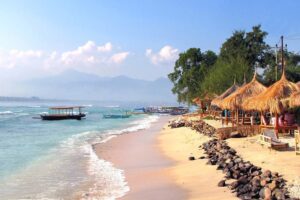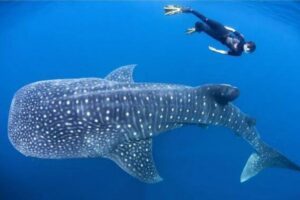
The first time I saw a whale shark, it didn’t feel real. I was in the waters off Sumbawa, having traveled from Lombok the day before. The sea was calm, the morning light soft and golden. Then a shadow moved beneath the boat—massive, slow, and graceful. My guide smiled knowingly. “That’s him,” he said.
As I slid into the water, my mask filled with the sight of white spots against deep blue. It’s impossible to explain the feeling fully. You’re face-to-face with the largest fish in the world, yet it feels like meeting an old, gentle friend. That moment stayed with me, and it made me curious: why exactly are whale sharks protected in Indonesia?
The Gentle Giants of the Ocean
Whale sharks (Rhincodon typus) are not predators like their name might suggest. They feed mostly on plankton, small fish, and tiny organisms, using their wide mouths like giant filters. Despite their size—some can grow over 12 meters—they move slowly and with an elegance that seems at odds with their bulk.
In Indonesia, especially in places like Saleh Bay in Sumbawa, whale sharks are part of the marine ecosystem’s delicate balance. They follow seasonal food sources, often appearing where fishing activity stirs up plankton-rich waters. Seeing them here is a gift, but it’s also a reminder of how fragile their world is.
Why Protection Matters
Indonesia officially protects whale sharks, making it illegal to hunt or harm them. The reasons go beyond just conservation; they’re about preserving biodiversity, supporting local economies through eco-tourism, and maintaining healthy oceans.
I remember talking to a fisherman in a small Sumbawa village who told me, “These fish bring people from far away. If we care for them, they’ll keep coming back—and so will the visitors.” That’s the heart of it: protecting whale sharks benefits both nature and people.
The Role of Sumbawa and Lombok in Whale Shark Tourism
Travelers often hear about Bali’s beaches or Komodo’s dragons, but few realize that one of the best places to encounter whale sharks is right here in Saleh Bay. Many visitors, like me, start their journey in Lombok, then make their way across to Sumbawa. The route is scenic, passing through quiet coastal towns and untouched landscapes before you reach the bay where the giants gather.
For anyone curious about the sumbawa whale shark from lombok experience, the journey is just as rewarding as the destination. You’re not only seeing wildlife; you’re witnessing a connection between land, sea, and community.
One of the most trusted ways to experience this is through a Saleh Bay whale shark tour, which prioritizes respectful interaction and follows guidelines to ensure the animals aren’t disturbed.
Respectful Encounters
Protection doesn’t just mean laws—it’s also about how we behave in their presence. In Sumbawa, the best guides teach you to keep your distance, avoid touching, and let the whale shark set the pace. I learned quickly that the most magical moments happen when you simply float and let the creature glide past, unbothered.
Some even turn towards you out of curiosity, their tiny eyes scanning as if deciding whether you’re worth a closer look. That kind of encounter feels intimate without crossing any lines.
The Science Behind Their Protection
Marine biologists working in Indonesia have discovered that whale sharks live long lives—some over 100 years—and mature slowly. This means their populations recover very slowly from any decline. If too many are killed or disturbed, it could take decades for numbers to bounce back.
Protecting them now ensures that future generations can still experience that moment of awe when a spotted giant emerges from the deep.
A Community Effort
It’s easy to think of conservation as the work of scientists and governments, but in Sumbawa, it’s often the local communities leading the charge. Fishermen adjust their nets, tourism operators follow strict codes, and visitors spread the word about responsible travel.
One evening, after a long day on the water, I joined a group of locals for coffee. The conversation kept circling back to the whale sharks—not as a tourist attraction, but as part of their identity. “They are our neighbors,” one man said. That sentiment has stayed with me.
The Experience of Seeing a Protected Giant
If you’re lucky enough to swim with a whale shark in Indonesia, especially in a place like Saleh Bay, you’ll understand why they’re worth protecting. The sheer size, the slow rhythm of their tail, the way sunlight filters across their dotted backs—it all feels otherworldly.
From Lombok, the trip to Sumbawa might seem like just another island hop. But in truth, it’s a journey into a different kind of beauty—one built on patience, respect, and the understanding that some treasures should be safeguarded, not taken.
Beyond the Photo Opportunity
It’s tempting to focus on getting the perfect picture, but the real value is in the memory. Watching a whale shark disappear into the blue is bittersweet—you want more time, but you also want them to keep their wild freedom.
For me, that’s the core of why whale sharks are protected in Indonesia. They remind us that not everything in the ocean is ours to control. Sometimes, the best thing we can do is ensure they have the space and safety to continue their ancient migrations.




